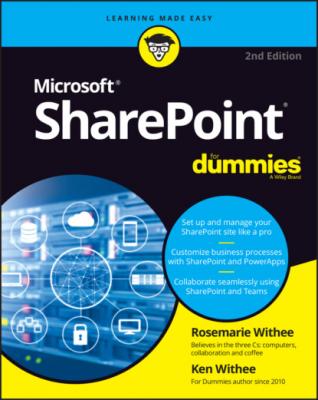SharePoint For Dummies. Rosemarie Withee
Чтение книги онлайн.
Читать онлайн книгу SharePoint For Dummies - Rosemarie Withee страница 18
 site.
site.
Understanding Why SharePoint Online Has Become So Popular
Putting a complex computer platform in place is difficult. Organizations discovered this when they implemented enterprise resource planning (ERP) software in the 1990s and 2000s, and it still holds true today. Putting the SharePoint platform in place is not an easy endeavor. Larger organizations usually require a more complex implementation. As the complexity of the implementation increases, so do the costs, time, and risk. The current best practice is to use an experienced consulting firm with expertise in implementing a SharePoint platform. As in dealing with any services company, sometimes you pick a winner, and sometimes it’s a complete disaster.
SharePoint Online takes the implementation of the infrastructure out of the equation with a known variable in cost and resources. This is music to a bean counter’s ears! Predictability! The predictability of cost and time to implement are why SharePoint Online and other cloud solutions are becoming so popular. They reduce complexity and provide a fixed and certain cost on a SharePoint platform that is guaranteed to follow best practices. Having a known variable in place for the infrastructure frees up resources to focus on the actual business problems. Which, by the way, are your main reasons for implementing SharePoint in the first place, right?
Differences between SharePoint Online and SharePoint On-Premises
In the past, there have been some major differences between SharePoint Online and SharePoint On-Premises. For one, SharePoint Online used to trail the version of SharePoint that was available on-premises. For example, when SharePoint 2016 came out, it took SharePoint Online a painfully long time before it became comparable to SharePoint 2016.
Times have changed, however. Microsoft has moved to focus on SharePoint Online instead of the on-premises versions. It rolls out new features in SharePoint Online, and then grabs a snapshot of the online version and makes it available for organizations that choose to deploy it themselves on-premises.
In fact, one of the major development areas with SharePoint Server 2019 is its integration with SharePoint Online. This is to accommodate organizations that want to keep some of their data on their local premises and in their own control, but want to leverage some of the benefits of having Microsoft manage SharePoint for them. This concept of using some SharePoint Online and some SharePoint On-Premises is called a hybrid approach.
With that said, there are still integration points with other local server products and advanced functionality that are only available with SharePoint On-Premises. This is an ever-changing landscape, so the best way to stay on top of the available features is on the frequently updated SharePoint Online feature matrix located on Microsoft’s docs.microsoft.com site. The best way to find the features is to search for “SharePoint service description.”
GETTING TO THE BOTTOM OF THE CLOUD
Network diagrams often show a network as a cloud, as shown in the following figure, because it would be too complex to diagram all the components that make up the network (such as routers, switches, hubs, and cables).
The biggest network, and cloud, of all is the Internet. When a diagram shows communication over the Internet, a big cloud is used because it would be impossible to try to show all the network hardware that might be encountered between two computers communicating via the Internet. The cloud simply becomes an abstraction for a network with the assumption that communication can occur over that cloud.
If a company sells access to software that lives in their data centers and that is connected to by customers over the Internet, that solution is said to live “in the cloud.” The term comes from the perspective of the customer, who may have no idea where the actual servers that serve up the software are located. From the customers’ perspective, they just access the software using an Internet domain name. This cloud concept and technology is nothing new. Whenever you surf the web, you use a service in the cloud. You just know that when you type in the web address, the site appears in your web browser. This concept is catching on with business applications; you hear more and more about cloud solutions.
Exploring the Benefits of SharePoint Online
If you use SharePoint in your day-to-day operations, the good news is that it doesn’t really matter whether you are using SharePoint On-Premises or SharePoint Online. They are both SharePoint, and you can focus on your job. With that said, it’s nice to at least have a high-level understanding of some of the infrastructure benefits to SharePoint Online. If nothing else, you can impress your IT friends.
Using SharePoint Online instead of trying to build and manage the platform with your own organization’s resources gives you a number of benefits. You simply sign up, pay a monthly licensing fee, and access SharePoint over the Internet. The following sections take a look at some of the things that Microsoft does behind the scenes with SharePoint Online.
Data center and hardware
If you have ever toured a data center, you have some idea of the amount of effort and resources it takes to keep everything running. Data centers have rows and rows of computers with flashing lights, humming fans, and coils of cables running ceiling to floor. Control rooms that resemble something NASA would use to run space missions monitor all these servers. The control rooms contain computers and monitors that report on everything in the data center, from temperature and humidity to individual fans in particular servers and everything in between. These control rooms are often called a network operation center (NOC) and are the nerve center for a modern data center.
Most organizations that have the need for servers find a data center that can be used to host their gear. Hosting your computers